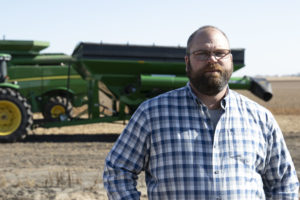
Partnerships That Drive Success
Guests: Todd Arduser, Kevin Poppel
In this episode of Channel Chat, farmer Kevin Poppel talks about the relationships and advice that have helped him find success in farming.
Listen to Episode
 Ag Over Easy Podcast
Ag Over Easy Podcast
How have constant weather challenges, delayed planting and prevent plant affected corn and soybean production numbers across the nation? USDA Crop Production/WASDE reports have been released, and grain marketing expert Matt Bennett weighs in on the results. Tune in to find out how markets and farmers reacted to the August reports and how the numbers could impact the rest of their season in this bonus episode of Channel Chat.


Matt Bennett is not only one of the industry's most respected grain marketing consultants but he's also a farmer himself. With a 3,000-acre corn and soybean farm, Matt understands firsthand the challenges and risks involved in being a farmer. Matt takes his decades of successful experiences, on and off the farm, to provide you with his time-proven approach to grain marketing.
Amity:
Hi there. Welcome to this bonus episode of Channel Chat. I'm your host, Amity Shedd. And today, grain marketing expert Matt Bennett and I will kind of be debriefing and digesting the August USDA supply and demand report that was released earlier today. Matt, let's start off with what jumped out to you the most about this report.
Matt:
You know, the thing that jumped out to me most about the report is that essentially, you raised corn production significantly, first of all. You know, when it comes to corn, most producers were expecting for yield to come down and for planted and harvested acres to come down. But so, the USDA essentially raised planted and harvested acres, raised the yield, you know, and so obviously, for corn, it was definitely a bearish report. That was probably the most surprising thing for me.
And then whenever I see … You know, the soybean report, to me, was also a bit of a head-scratcher. Now, they did lower the planted acres for soybean, which I agree with. But the thing that surprised me about soybean, they kept the yield at a 48.5 yield. For me, that's a really tough thing to believe given the fact that we planted the soybean crop so late. To think that we're only going to be three and a half bushels per acre below last year's record 52-bushel yield, it's something that I really find hard to believe.
Amity:
Right. Matt, there are a lot of questions when it comes to prevent plant acres. How do those play into this report?
Matt:
You know, prevent plant acres are definitely historic. Whenever you look at prevent plant acres in totality, among all crops, we are looking at 19.2 million acres. As far as corn is concerned, you're looking at 11.2 million acres of corn and 4.35 million acres of soybeans. Now, we do know the producers knew that they would get a much better payout for prevent plant corn than prevent plant soybeans. But we also know that they couldn't turn in more prevent plant corn and planted corn acres than what they had last year.
And so, the bottom line here is that prevent plant corn acres were just astronomically higher than anything we've ever seen. But whatever all this boils down to is the USDA is still suggesting that we planted 90 million acres of soybean. And so, I think it's a little bit interesting.
One thing you have to remember with prevent plant acres is that typically, when they first get published, they continue to get bigger. So more of those continue to get reported as you go throughout the year. And so August would be 11.2. Who knows what September's going to be, who knows what October's going to be, but there's no question that they're going to end up growing from where we are currently if we do anything like we've done previously.
Amity:
Right. And can you shed some light on the numbers? Does this all add up? Does it make sense to you? I've seen a lot of negative reactions on Twitter. What are your thoughts on that?
Matt:
Well, typically, you get a negative reaction from Twitter. You see a negative reaction from producers. And I'm going to tell you that I don't necessarily agree, you know, with what we saw today. I think that it will certainly, you know, the type of report that you want to forget, you know, because most producers, again, were thinking … Given the kind of weather that we had this year, it would be really tough to make the assumption that we would have similar production to what we've seen here in the last year to … But then the USDA comes to us and says, you know, as far as these U.S. corn and premium crops are concerned, we're still looking at rather large stocks and it's pretty tough to stay here and agree to that.
Now, as far as the producer's perspective goes, we have to remember that the August report typically is not one in which we've had a whole lot of luck in the past. Producers have been coming into that report thinking that the crop wasn't near as big as what, you know, it might have ended up being. And so, you know, the August report, historically, hasn't been a bullish report. And so we have to repeat those things in the back of our heads. That doesn't take the sting out of it by any stretch of the imagination, but for right now, I would say we've got to remember that we're very early in the marketing year.
You know, as far as total production goes, it's probably going to come down. We've got to assume that harvested acres are going to continue to come lower as prevent plant grows. And then as far as yield is concerned, it's still early in the game. But the bottom line is when you plant this corn crop and soybean crop historically later than what we typically do, it's going be really hard to get a firm handle on yields. And I think the USDA may have been a bit overly friendly to those numbers, or unfriendly, as far as the farmer's concerned today.
Amity:
Right. When we're talking about the farmers, I mean, this is obviously been a really tough and turbulent season, and this report that was released this morning doesn't help them feel any better about it. So where do we go from here? What do we do from here?
Matt:
Yeah, absolutely. That's a really, really good question. There's no question that from the producer's perspective, this was an ugly deal, significantly, this is a nasty report for us to deal with. Where does the producer go from here? Well, the first thing you’ve got to remember is that, again, this is really early in the marketing year.
The producers who made the most money selling their 2018 crop that was produced last year were the guys who waited until … and gals … who waited until the middle of the summer of 2019. So you have a long marketing window. I know that a lot of producers have felt like they wanted to hold off on making sales until they knew more about their crop given the uncertainty that we've seen this year. But at the same time, there's no big secret that most producers are a little bit more cash-strapped after having three or four really tough income years. So if they've held off on sales now, a lot of these guys and gals may feel definitely handcuffed, whether we're talking about old corn or new corn sales.
I know a lot of producers are still owing on the cash corn. They're hoping to see something happen here toward harvest time, especially given how late this crop is. Most people, I guess, were under the assumption that definitely had a lot of wet corn that was going to be coming to town this fall, and the elevator system was going to be wanting dry corn. So producers were really hoping to get that boost right there before harvest time.
So yeah, it's very confusing. Where do we go from here? I think we have to keep our heads up and understand, we're going to learn a whole lot more about this crop later. You know, it's going to take some time for us to get a true handle on what total production's going to be. But by any means, I don't want to get scared into making a bad marketing decision just because the market's down right now. I’ve got to remember that I've got quite a bit of time left to get this crop harvested and marketed.
Amity:
Right. And for those farmers and producers who are feeling the sting a little bit more than others, what's one piece of advice you can offer them after they see this report today?
Matt:
I think, you know, as we get into harvest, we've got to remember that we want to watch some cues that the market is telling us. So typically, whenever the market gets to where they want corn more now than later, then you won't see near the spread from, for instance, December to, like, July corn. Right now, December to July corn is 20 cents. A lot of times, you'll see a much bigger spread. This year, it looks like the market though is going to want those bushels maybe earlier in the year rather than later.
So as a producer who's really frustrated with what's going on, I want to watch the cues as to what the basis is telling me, what the cash market's telling me, and just try to go back to Marketing 101-type lessons. And if they need help that there's people like me in the industry and others who are really good at helping producers try to figure out the best way to maximize their profit margins and minimize risk. Because in a market environment like this, the number one thing we need to remember to do it to minimize our risk as much as possible.
Amity:
Sounds like it's going to be a pretty busy day for you.
Matt:
Yeah. It's certainly a challenge right now, but again, you know, market volatility is a good thing. Lots of times, we sit around here and the markets don't move in a couple, three weeks. It's frustrating for producers. They like to see a little bit of market action. I know they don't want to see this today, but hopefully, we'll be able to get a little bit more light shed on this later on down the road. And maybe we'll see, you know, some base like this on the other side of the coin.
Amity:
OK. Well, thanks, Matt, for joining us today. Is there anything else you'd like to add?
Matt:
No, just that we've got to keep our heads up. I know it's frustrating and it's, you know, I hope that the producers who are listening to this still have an opportunity to, you know, maybe catch some much-needed rain. I know in our part of the world, it's extremely dry, so you know, it's especially tough on a producer who’s seeing this market whenever the weather stinks. So, hopefully, we'll get some good weather going into harvest and maybe we'll get a little bounce to market at some point.

Guests: Todd Arduser, Kevin Poppel
In this episode of Channel Chat, farmer Kevin Poppel talks about the relationships and advice that have helped him find success in farming.
Listen to Episode

Guests: Colby Woods, Jessica Grubbs
As technology in agriculture continues to evolve, Channel Seedsman Colby Woods wanted to get ahead of the pack and offer drone scouting to his farmers in Eastern Nebraska. We caught up with Colby in Wahoo, Nebraska, along with Sentera Sales and Training Specialist Jessica Grubbs. Listen in this episode of Channel Chat.
Listen to Episode